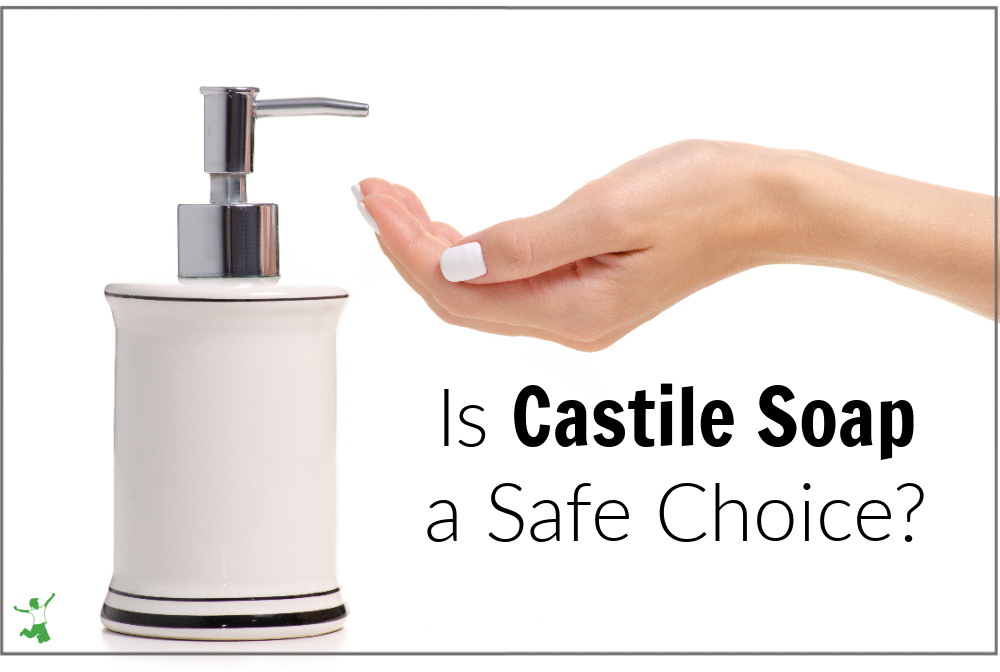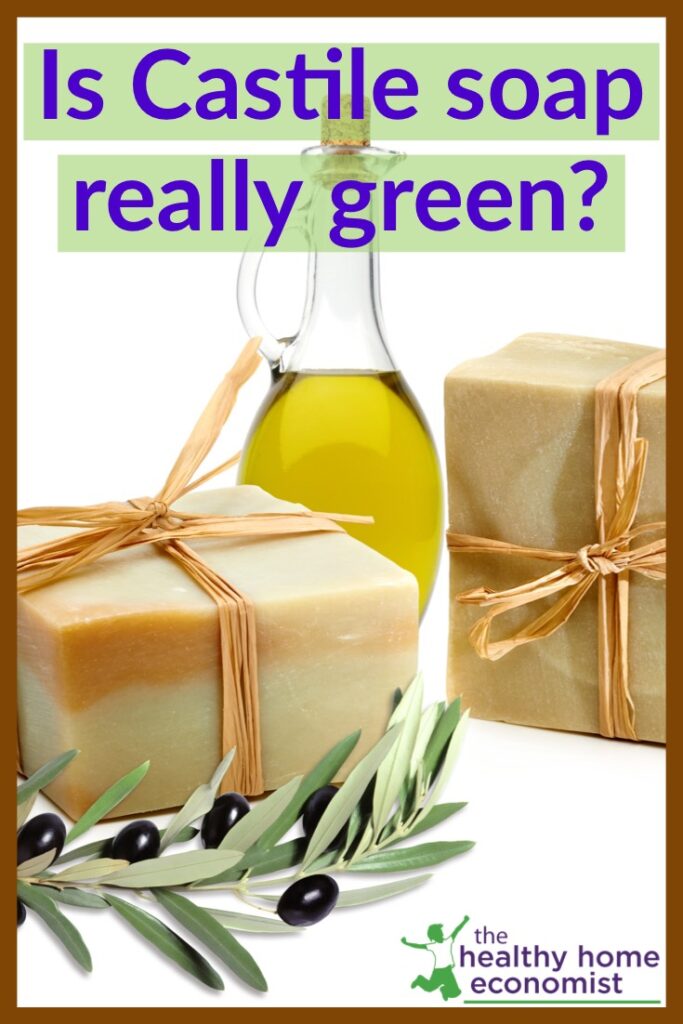Castile soap is a very popular choice for personal care and cleaning. Be aware of these tips to know what to buy and to avoid low-quality brands with unnecessary and potentially toxic additives.

The first time you browse the personal care aisles of a health food store, it’s hard not to immediately notice the numerous, colorful bottles and bars of Castile soap on display.
These brands are obviously good sellers, which is why retailers allocate them prime shelf space.
Just because an item is popular and sits on the shelf of a health food store, however, doesn’t necessarily make it a healthy nor even a green choice.
Any veteran foodie or greenie knows this to be true!
So what’s the real story behind Castile soap?
Is this product truly worth your budget dollars to purchase? Is it a safe personal care item for your family to be using?
Or, is it just another product that has been twisted by manufacturers into a modern-day version of its historical self that has little resemblance chemically or otherwise to its traditional roots?
History of Castile Soap
Castile soap, pronounced “kas-teel”, is rooted in the traditions of the Eastern Mediterranean where Aleppo soap makers made hard cleansing bars out of laurel oil and lye.
Laurel oil is derived from the aromatic Laurus nobilis, an evergreen tree or large shrub with green, glossy leaves and is native to Syria.
To this day, the origins of Aleppo soap remain unclear. Claims that the Egyptian Queen Cleopatra and Queen Zenobia of Syria used Aleppo soap abound but have yet to be verified.
As of this writing, we only know for sure that this important precursor to Castile soap cleansed the skin and hair of humankind for millennia.
The common belief is that the Crusaders brought Aleppo soap back to Europe with them during the 11th century.
Since laurel oil was not available in this part of the world, it was replaced with olive oil in the Castile region of Spain.
Castile soap was born!
Castile soap is known today as any vegetable oil-based soap. This distinguishes it from soaps made with animal fat such as tallow, lard, or goat milk.
Hence, the Castile soaps of today are commonly made with olive oil, coconut oil, palm oil, and others.
Castile Soap-Making
Traditional Castile soap is made by blending olive oil and lye. Lye, also called caustic soda, is the common name for sodium hydroxide or potassium hydroxide. Both are highly alkaline, liquid compounds.
They are also very caustic. Food grade lye is used to cure a wide variety of foods with lower grades of lye used in drain de-cloggers and oven cleaners.
Both the sodium hydroxide and potassium hydroxide forms of lye are used in making soap. Sodium hydroxide is favored for making solid Castile soap with potassium hydroxide used for liquid soaps.
They are not interchangeable, however. Potassium hydroxide-derived Castile soaps are more easily dissolved and diluted in water and are hence favored for liquid soap production for this reason.
The typical cold process method for making Castile soap is as follows:
- Lye is mixed with water.
- Vegetable oils and fragrances blended into the lye mixture.
- The gradual chemical reaction between the lye and the fats produces a solid soap as the mixture ages or “cures” over a period of several months.
While the cold process method is very straightforward, the hot process method for making Castile soap is actually far more popular.
It significantly reduces cure time from months to a few weeks and requires a smaller amount of essential oils to scent.
Hot process Castile soap is made using either the stovetop, a crockpot, or even in the oven. Only olive oil, distilled water, and lye are needed. (1)
Commercial Brands
Due to the long curing time required to make traditional castile soap, consumers have flocked to commercial preparations.
The good news is that some truly traditional, green Castile soaps are available. The bad news is that consumers would do well to avoid some brands that include unnecessary, even toxic, additives.
What should you look for as an educated consumer?
First of all, the old rule of thumb “the fewer ingredients the better” definitely applies to Castile-based soaps. Ideally, a liquid or bar should contain just three ingredients: oil, distilled water, and lye (either potassium or sodium hydroxide).
All of these ingredients are considered safe, certainly in the dilute amounts found in Castile soap.
Even at full strength, the Environmental Working Group (EWG) identifies lye as a low health risk with skin, eye, or lung irritation possible only when precautions are not taken. (2)
This is why rubber gloves and protective eyewear is necessary when making Castile soap yourself at home.
As a result, buying Castile soap either in bar or liquid form from the store is definitely a green choice when the manufacturers use just a few simple ingredients.
Which Oil is Best?
Olive oil is the most traditional oil for authentic Castile soap. However, any healthy fat will do the job. Coconut oil and palm oil are other excellent choices from when sustainable sources that are ideally organic.
Avoid soy or canola-based Castile soap as these are likely GMO unless certified organic.
A GMO-based soap would likely contain pesticide residues and be an unsustainable choice from an environmental point of view.
Watch out for Toxic Additives
Additional ingredients beyond the three basic ones described above are not necessarily a problem.
As a savvy consumer, be sure to read Castile soap labels and be aware that some non-green, unhealthy additives are possible that you need to watch out for.
Some common additives to commercial brands of Castile soap include:
- Fragrance
- Citric acid
- Glycerin
- Ethanol
- Calcium Carbonate
- Tocopherol (Vitamin E)
- Menthol
- Xanthan gum
- Potassium Cocoate
- Baking soda
- Silica
- Sodium Chloride (salt)
- Variety of essential oils and herbal extracts
The three ingredients marked in red above are the ones that are cause for concern.
Glycerin and citric acid, while generally nontoxic according to the EWG Skin Deep database, could be of GMO origin (either corn for citric acid or soy oil for glycerin). Be sure to check with the manufacturer of the Castile soap brand you prefer to be sure of nonGMO ingredients.
The ingredient with the biggest risk in Castile soap is fragrance. It has as a high hazard (8 on a scale of 10) by EWG. Castile soap or any personal care product that contains it has these health risks:
The word “fragrance” or “parfum” on the product label represents an undisclosed mixture of various scent chemicals and ingredients used as fragrance dispersants such as diethyl phthalate. Fragrance mixes have been associated with allergies, dermatitis, respiratory distress and potential effects on the reproductive system. (3)

Safest Ingredients
In sum, if you purchase Castile soap in either liquid or bar form, ensure that the label lists only basic ingredients such as nonGMO vegetable oil(s), distilled water, and lye (such as this brand).
A natural preservative such as tocopherol (Vitamin E) is fine too.
If you really prefer scented versions of Castile soap, be sure to purchase only those that use essential oils or herbal extracts.
Avoid brands that contain the word “fragrance” on the label. This ingredient is not a green and healthy option for you or your family.
Synthetic fragrances can negatively affect hormone health among other risks.
Be aware that some brands market Castile soaps that are healthy and others that are not.
Yes, even within the same brand, you must double-check ingredients to be sure the one you buy is truly green!
If you are unsure about the brand you use, be sure to check it in the Skin Deep database for peace of mind! (4)
Most Popular Uses
The savvy consumer can find dozens of uses for Castile soap around the home. The top 10 most popular uses include:
- Bathing (including washing hands – MUCH healthier and greener option than probiotic-stripping anti-bacterial soaps!)
- Shaving
- Brushing teeth and gums
- Washing produce
- Washing dishes
- Laundry
- Mopping floors
- Bathing pets
- DIY pest control in and around the home and garden
Do you use Castile soap? If so, do you make it yourself or purchase from the store? What are your favorite ways to use this green cleaner around your home?
(1) Hot Process Method for Making Castile Soap
(2) Sodium Hydroxide (Lye)
(3) Fragrance
(4) Environmental Working Group Product Database








Dr Bronners unscented does have citric acid in it. Is there a different one you recommend?
Dr Bronners unscented must have been reformulated because these are the ingredients now
Water, Organic Coconut Oil*, Potassium Hydroxide**, Organic Palm Kernel Oil*, Organic Olive Oil*, Organic Hemp Seed Oil, Organic Jojoba Oil, Citric Acid, Tocopherol
Wow! Not cool!
Yeah, Bronner made their employees get the C jab. #hardpass
No way! That is awful coming from a supposedly natural company. Thank you for the information, #hardpass for me also.